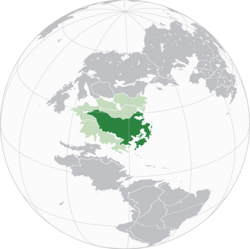Nuclear weapons and the Federated Fire Territories
This article is incomplete because it is pending further input from participants, or it is a work-in-progress by one author. Please comment on this article's talk page to share your input, comments and questions. Note: To contribute to this article, you may need to seek help from the author(s) of this page. |
| Federated Fire Territories | |
|---|---|
 | |
| Nuclear program start date | 1946 |
| NPT party | Signatory of STAPNA |
The Federated Fire Territories commonly known as Fyrland, was the # country after New Tyran and Sieuxerr to develop and test nuclear weapons, and is one of the signatories to the STAPNA agreement.
Although the Fyrish scientific community was aware of global discourse on the feasibility of an atomic bomb throughout the 1930s, plans to develop such a weapon existed only in passing proposals by 1940, and an assessment program was only initiated by 1943; the assessment program was initiated due to the conspicuous lack of scientific publications regarding the study of nuclear fission, by Anglian, Glasic, and Sieuxerrian scientists, as Fyrish physicists suspected that the Entente powers had secretly begun development of a "superweapon".
No practical effort was made to pursue the program, until the aftermath of the first use of atomic weaponry on Takena and Nakazara in Dayashina in 1946, which gave the impetus to fully initiate a nuclear weapons programme, codenamed Fenix.[1]
Accelerating feasibility
With the steady stream of scientific publications regarding nuclear fission abruptly tailing off with the start of the Pan-Septentrion War, Fyrish physicist Eadgar Tafari Desta promptly took it upon himself to raise concern over the fact, as he suspected a conspiracy by the Entente powers to develop a "superweapon". Strong lobbying efforts by Fyrish physicists and scientists, lead by Eadgar Tafari Desta at the start of 1940, managed to convince the government to setup an assessment program by 1943, which was to address the "uranium issue", Isotope separation, and investigate the possibility of a chain reaction weapon.
Early efforts centered around the issue of isotope seperation, as the properties of Uranium-235 (U-235) regarding its tendancy to release two neutrons when undergoing fission, were known since 1935, which made it a prime candidate for a chain reaction. The primary issue with U-235, was although it was naturally occuring, the abundance of U-235 in natural uranium was known to be approximately 0.7%, whilst being chemically identical to the main constituent of natural uranium, which was U-238; Isotope-238 was known to be fissionable but not fissile, which made it incapable of supporting the slow neutron chain reaction bomb concept. With no progress being made on the seperative work process by 1946, due to the programs strictly assessment nature, sufficient quantities of uranium isotopes were never made available to the assessment program, which were required in order to conduct tests to ascertain data as to the true nature of a chain reaction bomb.
The situation changed dramatically when the Federated Fire Territories learned of the atomic bombings of Takena and Nakazara in 1946. Immediately after the atomic bombing, the assessment program was moved to live project status under the codename Fenix, and given top priority to national defence. From this point, the work on the program was carried out quickly, resulting in the first nuclear reactor being constructed near Britræᵹ on February 5, 1947.
Notes
- ↑ Project codename Fenix translates as Phoenix.
